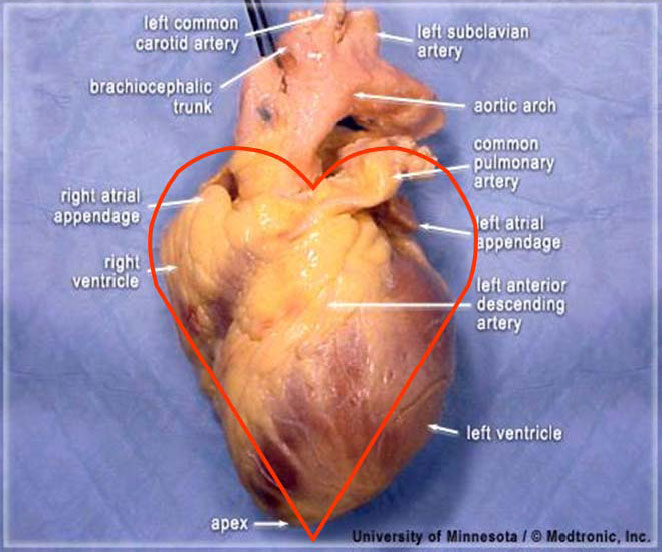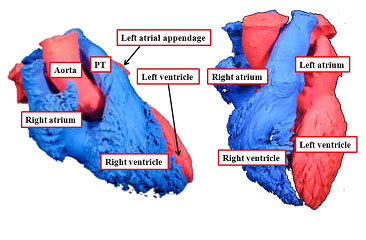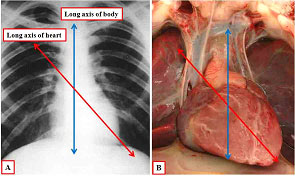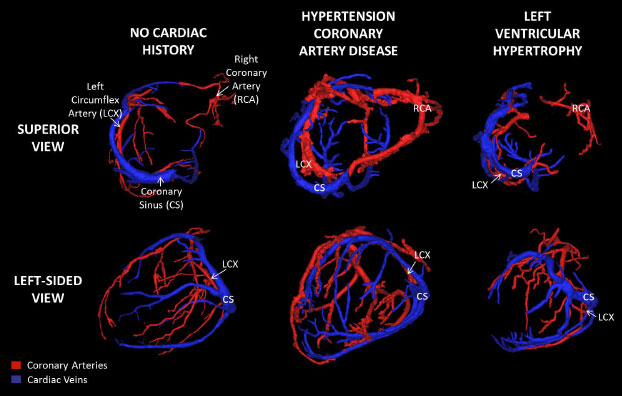|

A human heart viewed from the so-called anterior position, demonstrating the
valentine heart orientation used by many to incorrectly describe anatomy. The red line
surrounding the heart is the characteristic symbol, which was theoretically derived
from observing the heart in this orientation.
|
Anatomy is one of the oldest branches of medicine, dating back as far as the 3rd century
B.C. Throughout time, the discipline has been served well by a universal system for
describing structures based on the anatomic position. Unfortunately, cardiac anatomy has
been an outlier from this long-standing tradition. Cardiac anatomy has often been
incorrectly described using confusing and inappropriate nomenclature. This is most likely
due to the examination of the heart in the valentine position, in which the heart stands on
its apex as opposed to how it is actually oriented in the body. The description of the major
coronary arteries, such as the anterior descending and posterior descending, is
attitudinally incorrect; as the heart is oriented in the body, the surfaces are actually
superior and inferior. (Hill, 2015)
Cardiac anatomy has often been incorrectly described because in early anatomy literature
the examined heart was placed in the valentine position: in which the heart stands on its
apex as opposed to how it is actually oriented in the body.
|
Blood volumes: Attitudinally Correct Versus Valentine

The left-hand panel shows casts of the cardiac cavities positioned as the heart
usually lies within the thorax. The so-called right chambers have been cast in blue
and the alleged left chambers in red. As can be seen, in reality, the right atrium and
ventricle are largely positioned in front of their left sided counterparts. All that
is seen of the left atrium is the tip of the appendage. So as to see all four cardiac
chambers, it is necessary to rotate the casts in both the right to left and posterior
to anterior planes.
|
|

The left-hand panel (a) shows a typical chest radiograph, illustrating the marked
angulation between the long axis of the body (blue arrow) and the long axis of the
heart (red arrow). As shown in the right-hand panel (b), the prosector in the autopsy
room obtains the same information when observing the heart as it usually lies within
the mediastinum
|
|
Coronary Arteries

The description of the major coronary arteries, such as the anterior descending and
posterior descending, is attitudinally incorrect; as the heart is oriented in the
body, the surfaces are actually superior and inferior. (Hill, 2009)
|
The incorrect use of anatomic terminology to describe the heart can be considered to
impact a large and diverse group of individuals. Practitioners of medicine, such as
interventional cardiologists and electrophysiologists are affected, as are scientists
investigating the heart and engineers designing medical devices. It is considered here that
describing terms in a more consistent manner, and thus using the appropriate terminology,
would greatly increase the efficiency of interactions between these groups.
As the field of cardiac anatomy continues to play an important role in the practice of
medicine and the development of medical devices, it benefits all involved to adopt commonly
used terminology to describe the heart and its proper location in the body. Furthermore, it
may be of great utility to describe the cardiac anatomy of major animal models using the
same terminology as that of humans, at least when comparisons are being made between
species. Finally, due to advances in 3D and 4D imaging and their growing use in the cardiac
arena, a sound foundation of attitudinally correct terms will benefit everyone involved.
References:
- Iaizzo PA, Anderson RH, Hill AJ: The importance of human cardiac anatomy for translational research. Journal of Cardiovascular Translational Research, Special Issue on Cardiac Anatomy 6:23139059, 2013. PMID: 23139059
- Hill AJ: Attitudinally correct cardiac anatomy. In: Handbook of Cardiac Anatomy, Physiology, and Devices, 2nd, 3rd editions. Springer, Chapter 2, pages 15-22 , 2009, 2015.
- Anderson RH, Hill AJ: The importance of human cardiac anatomy for translational research. Journal of Cardiovascular Translational Research, Special Issue on Cardiac Anatomy 6:23139059, 2013. PMID: 23139059
- McAlpine WA (1975) Heart and coronary arteries: an anatomical atlas for clinical diagnosis, radiological investigation, and surgical treatment. Springer-Verlag, New York.
|



